There is increasing interest around the world in designing policies to curb carbon dioxide emissions, which are driven in large part by economic activity. This column identifies that the macroeconomic variables most related to the annual growth of per capita emissions in Spain from 1965 to 2020 were private consumption and maritime transport of goods. This contrasts with the US, where industrial production is the leader, suggesting that country-specific measures should be designed to decrease carbon dioxide emissions. For Spain, the authors recommend consumption local goods coming from clean production systems.
Carbon dioxide (CO2) emissions, largely a by-product of energy consumption, account for the largest share of greenhouse gas (GHG) emissions, generating detrimental effects on climate, sea level, the ocean’s pH, and world agriculture. The Kyoto Protocol, an environmental agreement adopted in 1997 by parties to the United Nations Framework Convention on Climate Change (UNFCCC), aims to curb global CO2 emissions. In particular, with the 2030 Climate Target Plan, the European Commission proposes to raise the EU’s target by reducing GHG emissions to at least 55% below 1990 levels by 2030. As a result of the link between climate change and pollution, interest in measuring and forecasting the latter has been increasing over the last decades; see, for instance, Friedlingstein et al. (2022) for a description of the Global Carbon Project that produces worldwide projections of CO2 emissions in preparing the annual Global Carbon Budget, which is considered in the Integrated Pollution Prevention and Control (IPPC) reports.
From 2008 to 2021, the main pollutants in Spain were CO2, methane, nitrous oxide, hydrofluorocarbons, nitrogen oxides, and sulphur oxides. CO2 emissions account for the largest share of GHGs (see Figure 1). Emissions decreased during this period, with a few exceptions. In 2020, due to the Covid-19 lockdown, emissions experienced a significant decrease. However, the Spanish National Institute of Statistics estimated an increase in emissions for 2021. Another large increase was expected for 2022 due to the war in Ukraine and the corresponding rise in energy consumption from more polluting sources. Emissions of the other pollutants decreased during this period and as a proportion of total GHG emissions.
Figure 1 CO2 emissions represent the largest share of greenhouse gases in Spain
Evolution of main pollutants from 2008 to 2021
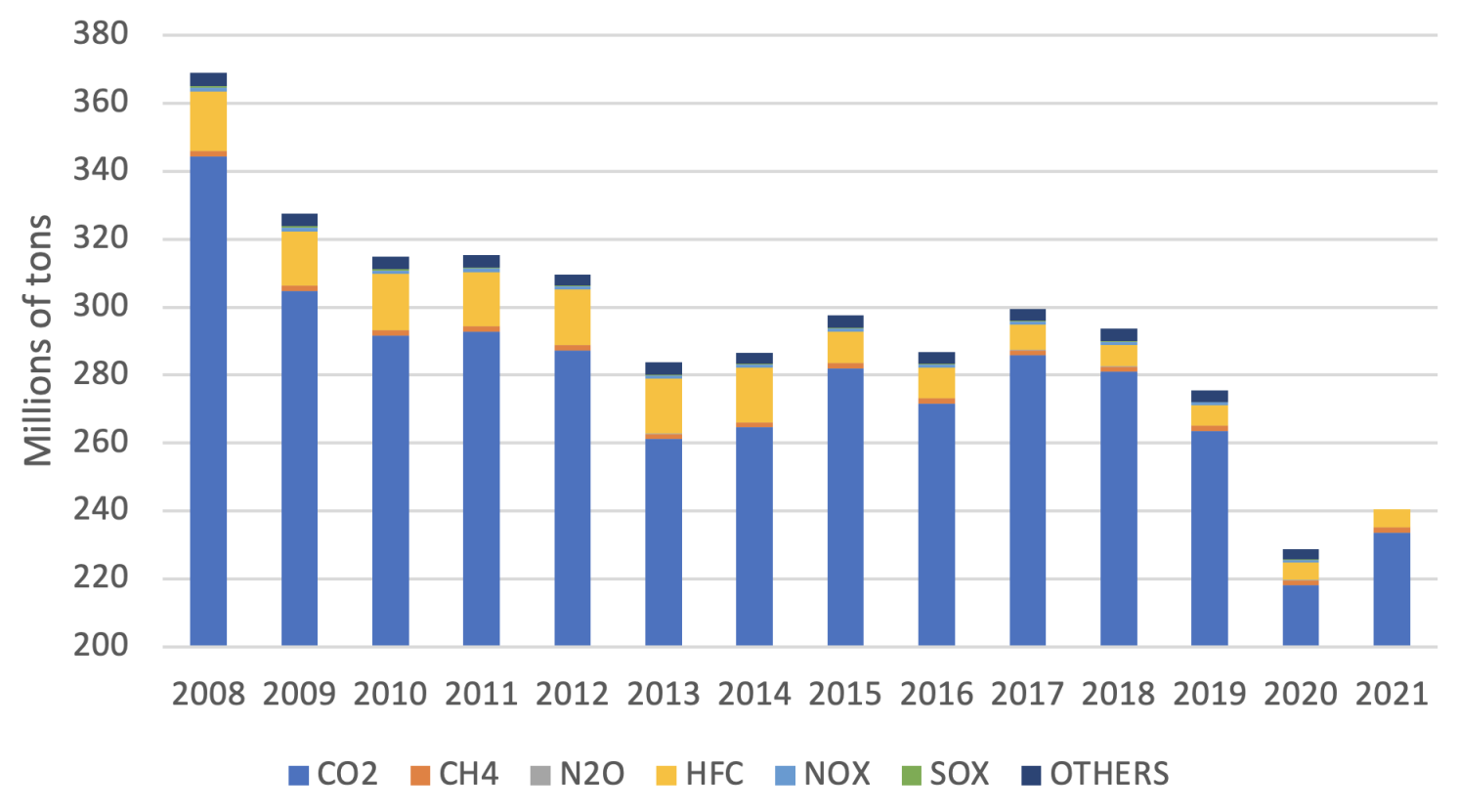
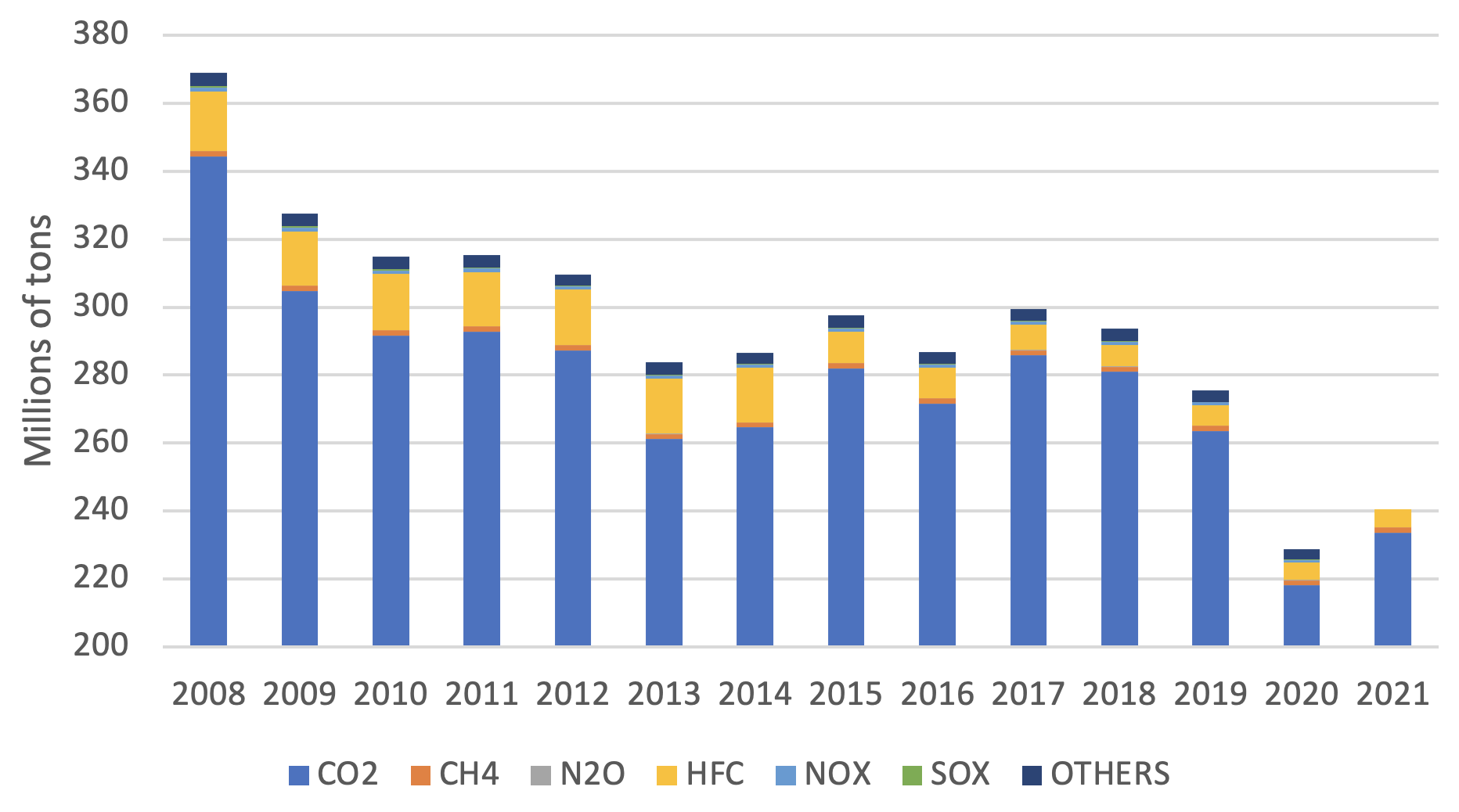
Source: compiled by the authors based on data from the Spanish National Institute of Statistics.
Emissions of CO2 mainly result from economic activity. Figure 2 plots the total GHGs for three years (2008, 2014, and 2021). There was a significant decrease in total GHG emissions from 2008 to 2021 in all sectors except for transport, which experienced a small increase in 2021 compared to 2014. This increase could be attributed to a rise in road transport activities in Spain. Industry and households are always the most polluting sectors. The energy sector was also highly polluting in 2008, but has shown a significant decrease since then.
Figure 2 Greenhouse gas emissions dropped from 2008 to 2021 in all sectors but transport
Total greenhouse gas emissions by sector in 2008, 2014 and 2021
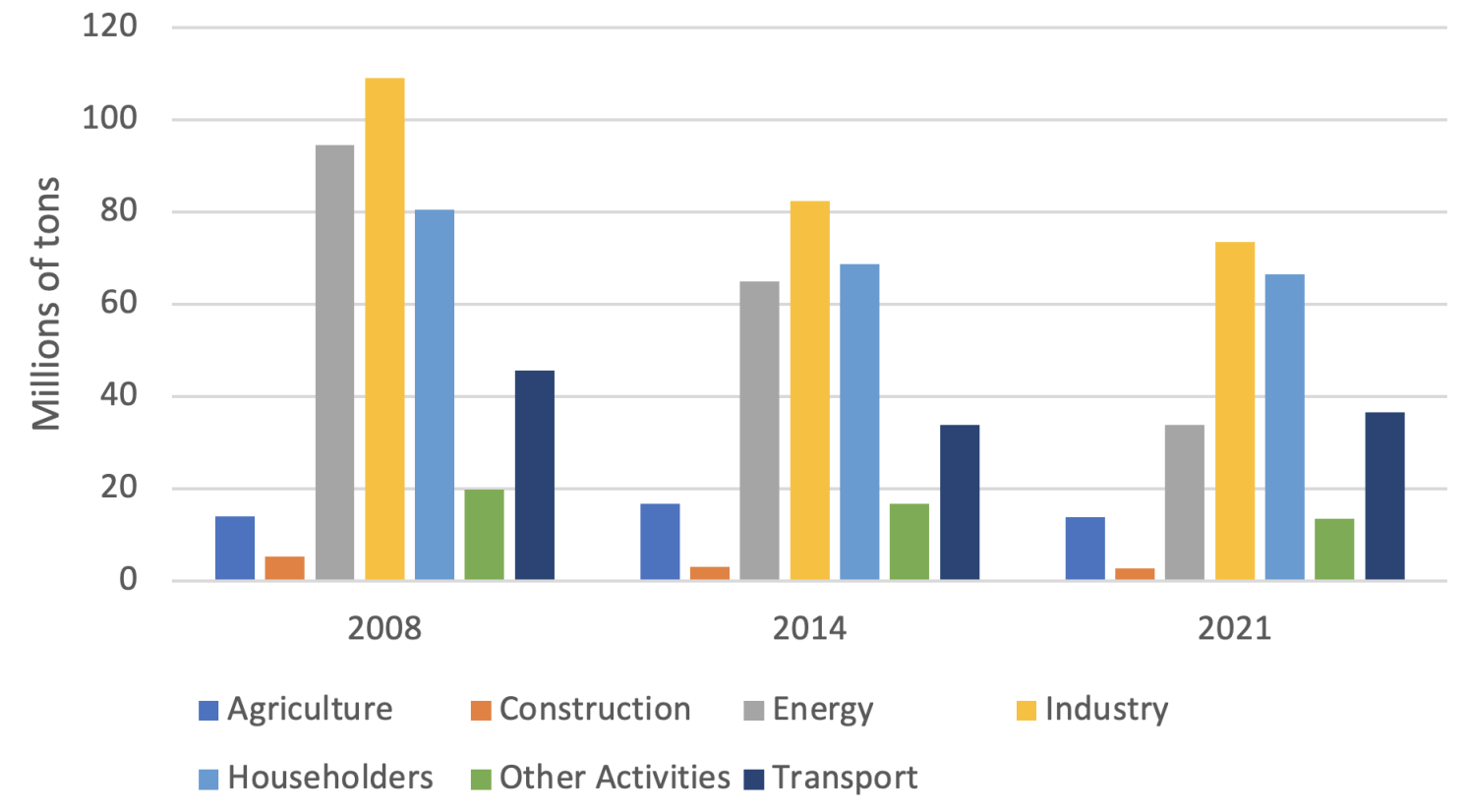
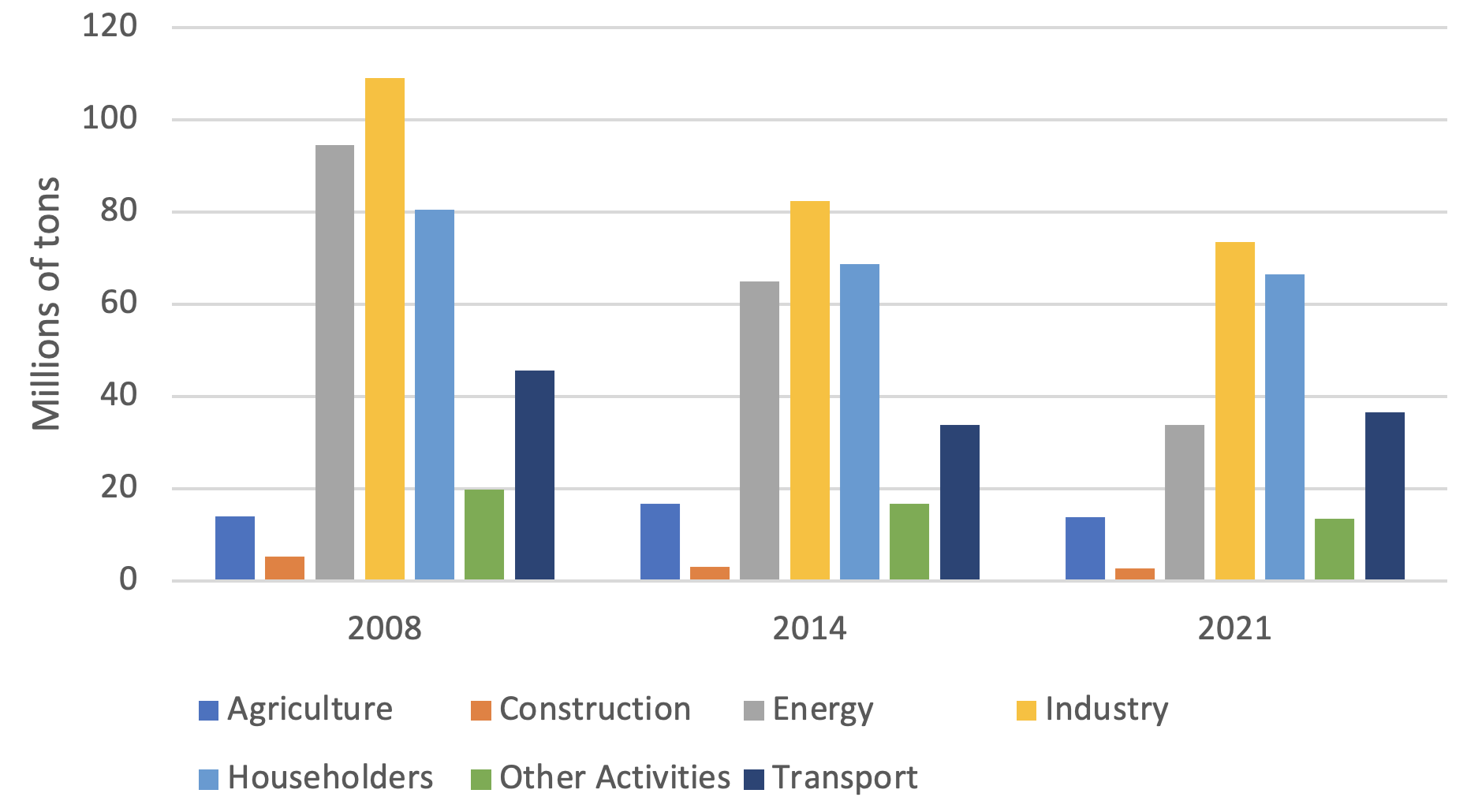
Source: compiled by the authors based on data from the Spanish National Institute of Statistics.
In terms of the contribution of each sector to GHG emissions, the energy sector has decreased its share, while the agricultural sector has increased its contribution (Figure 3). The shares of the industrial and household sectors remain more or less unchanged. This information can help the government to decide in which sectors to implement measures in order to achieve the targets set by the EU for 2030.
Figure 3 The energy sector has decreased its share of greenhouse gas emissions, while the agricultural sector has increased its contribution
Proportion of greenhouse gas emissions by sector in 2008, 2014, and 2021
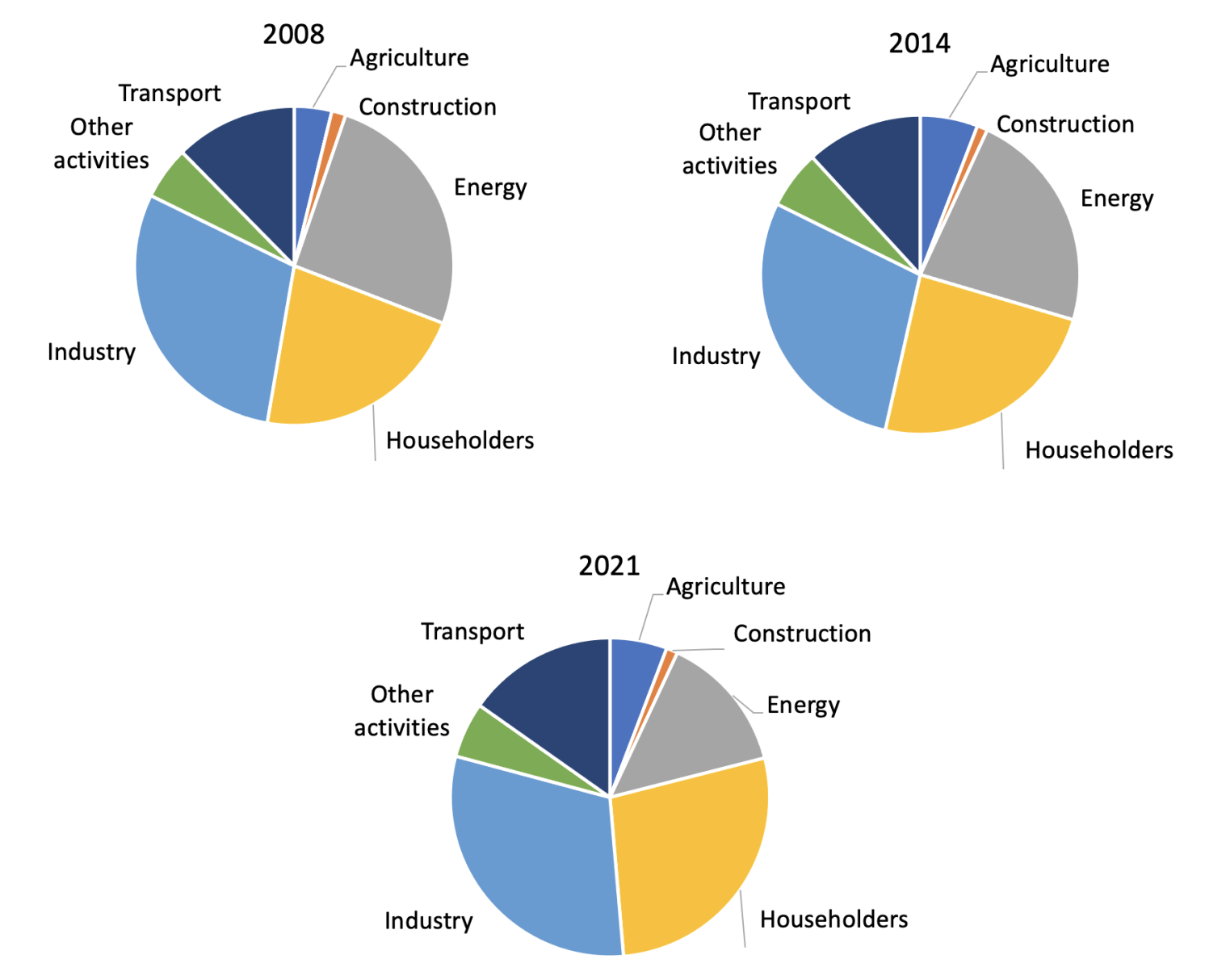

Source: compiled by the authors based on data from the Spanish National Institute of Statistics.
Finally, there was a clear decrease in total GHG emissions from 2008 to 2021. A very high proportion of emissions is associated with industrial and household activities, accounting for more than 50% of the total emissions (see Figure 3 and Table 1). Therefore, if Spain wants to comply with the commitments made at various climate summits, the government should focus its efforts on reducing emissions from these sectors.
Table 1 Total GHG emissions by sector


Note: * Preliminary results.
Source: compiled by the authors based on data from the Spanish National Institute of Statistics.
The transport sector also shows an increase compared to 2008, mainly due to the rise in road transport associated with online shopping in Spain during and after the pandemic. Furthermore, the agricultural sector should also be carefully monitored as its share of emissions has increased, primarily due to higher nitrous oxide emissions from agricultural soil management and urea application. There has also been an increase in livestock, leading to higher methane emissions. Nonetheless, it is worth noting that emissions from the energy sector decreased dramatically from 2008 to 2021.
Private consumption and maritime transport of goods are the greatest contributors to CO2 emissions
As early as 1991, Nordhaus (1991) discussed the economic implications of pollution. Since then, the bulk of research on the relationship between pollution and economic activity has focused on estimating the long-run environmental Kuznets curve (EKC) based on panel data (see the recent survey by de Juan et al. 2022). In the context of the Iberian Peninsula, the EKC has been analysed by Moutinho et al. (2017), who fit a panel model to observations of CO2 emissions and growth of 13 sectors observed yearly from 1975 to 2012, finding support for the EKC. Alternatively, De Juan et al. (2023) build a database representing the Spanish economy using 200 macroeconomic variables from 1965 to 2021 and apply statistical and econometric methods based on multivariate models with unobserved underlying factors to identify the variables that best explain the variation in the growth in CO2 emissions (see Fosten 2019, Bennedsen et al. 2021, and de Juan et al. 2023 for details of the methodology). The growth in private consumption and maritime transport of goods correlates with the growth of CO2 emissions (see Figure 4). These variables reflect the structure of Spain’s small, open economy, which is oriented to services and trade. The government should look closely at these two indicators if Spain is to reach the target established by the EU.
When compared to private consumption and maritime transport of goods alone, CO2 emissions grew by 73% from 1965 to 2021 and represent the largest share of the total percentage increase (102%), suggesting that policies targeting these variables could be more effective than those directed at economic activity in general. Moreover, private consumption and maritime transport of goods are closely related to the sectors that contribute the most to pollution; the former is related to the household sector, and the latter is associated to the transport and storage sector, which are two of the three most polluting sectors.
Figure 4 Annual variations of per capita in CO2 emissions in Spain and their economic drivers
Standardised variations observed annually from 1965 to 2021 (%)

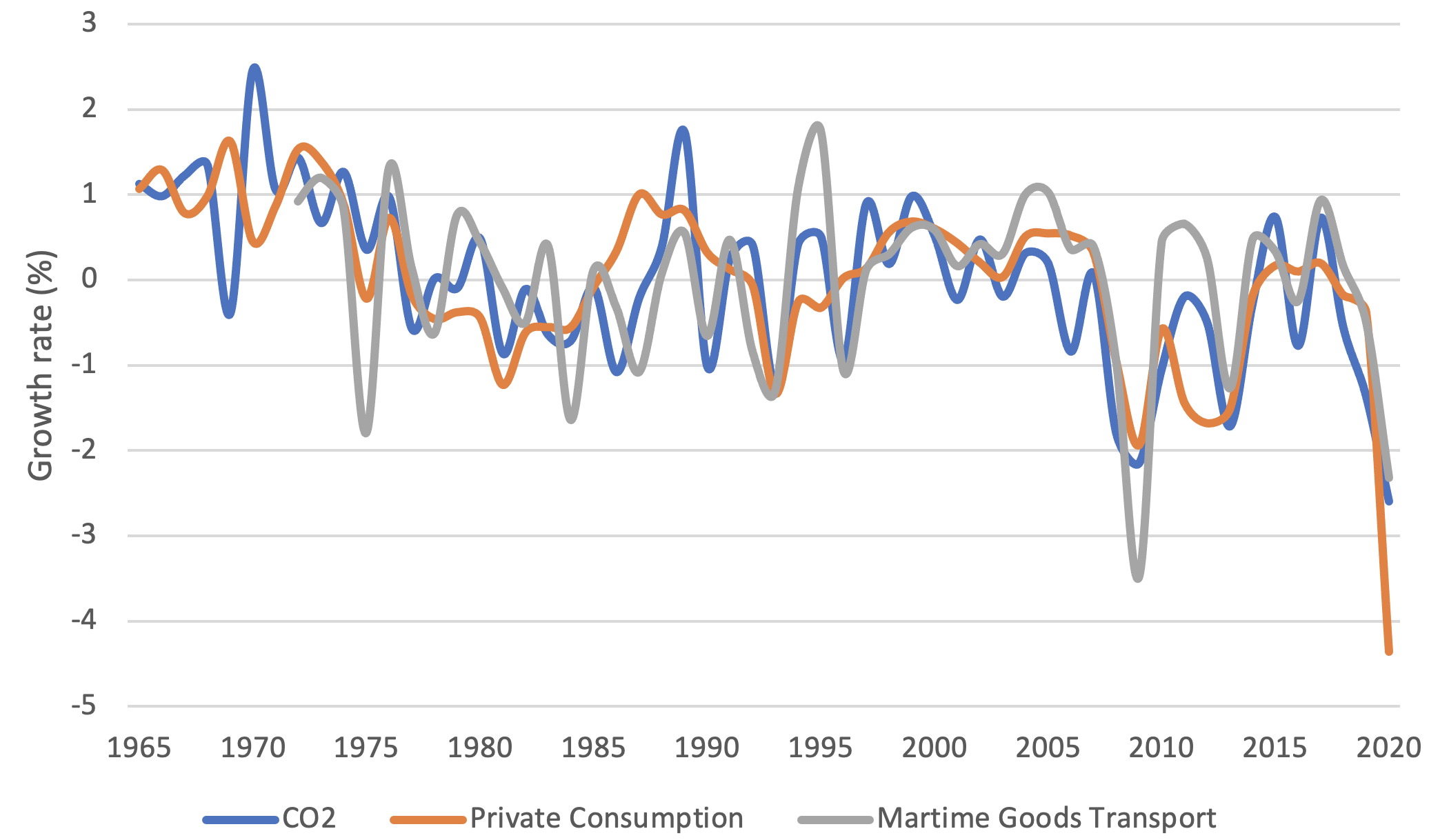
Source: compiled by the authors based on data from the Spanish Government, Ministry of Finance and Public Administration, Ministry of Labour and Social Economy and Ministry of Economic Affairs and Digital Transformation and from the Bank of Spain.
Reducing emissions in Spain requires clean local production
Private consumption and maritime transport were the main drivers of CO2 emissions growth in Spain from 1965 to 2021. Policy measures aimed at decreasing CO2 emissions in Spain should target these two variables. Producing goods locally would decrease CO2 emissions in Spain, although emissions due to production would increase. Therefore, the optimal solution could be to consume local goods from clean production systems. Currently, a percentage of Spain’s consumption comes from goods produced abroad because they are cheaper, even considering transport costs. However, consumers do not pay directly for the pollution generated by transport. If consumers had to pay for CO2 emissions, it could potentially shift demand towards local goods. Notably, the main drivers of CO2 emissions are not the same for all economies. For example, in the US, the main driver is industrial production. Therefore, effective policy measures should be country specific.
Source : VOXeu



































































